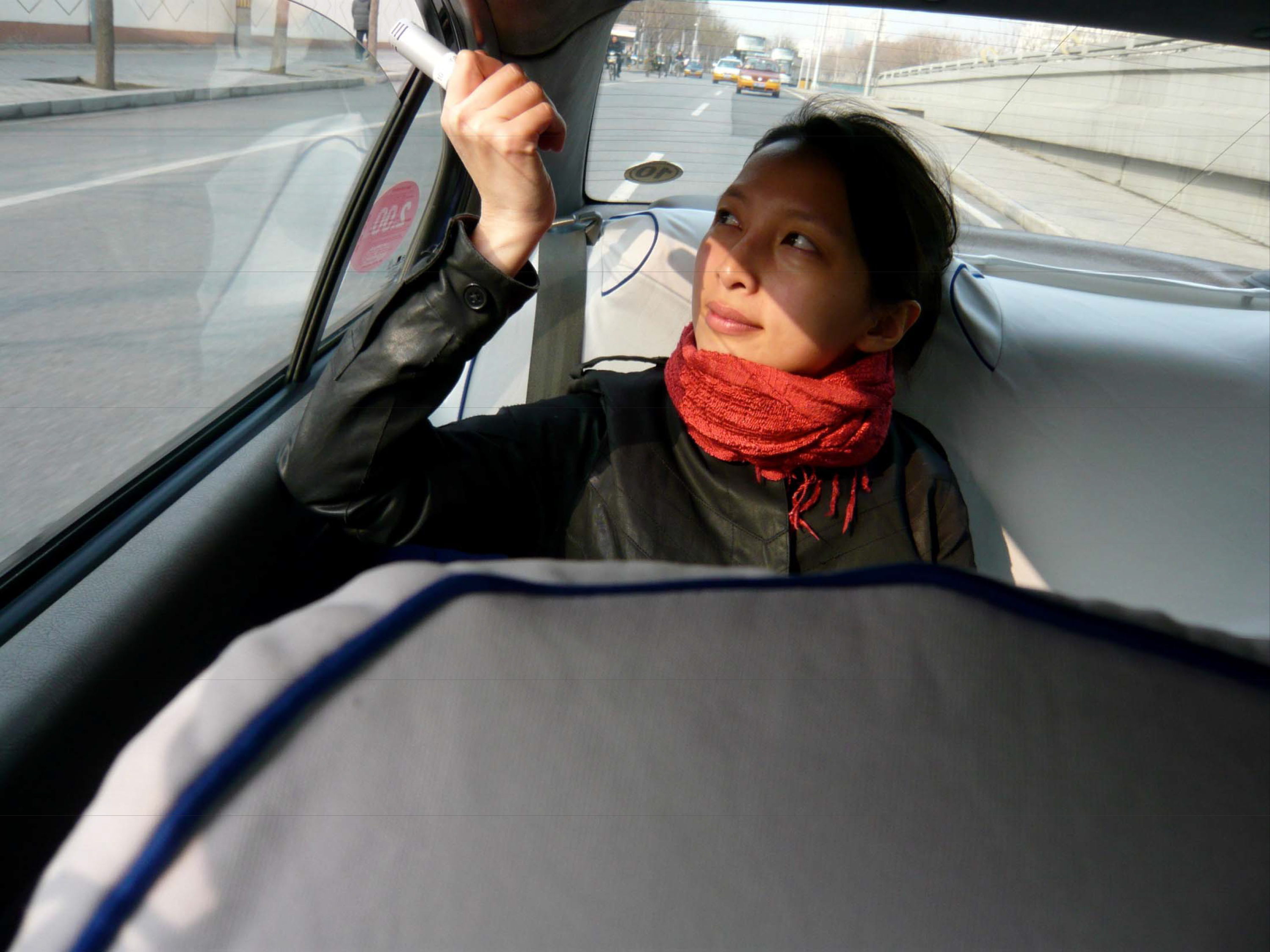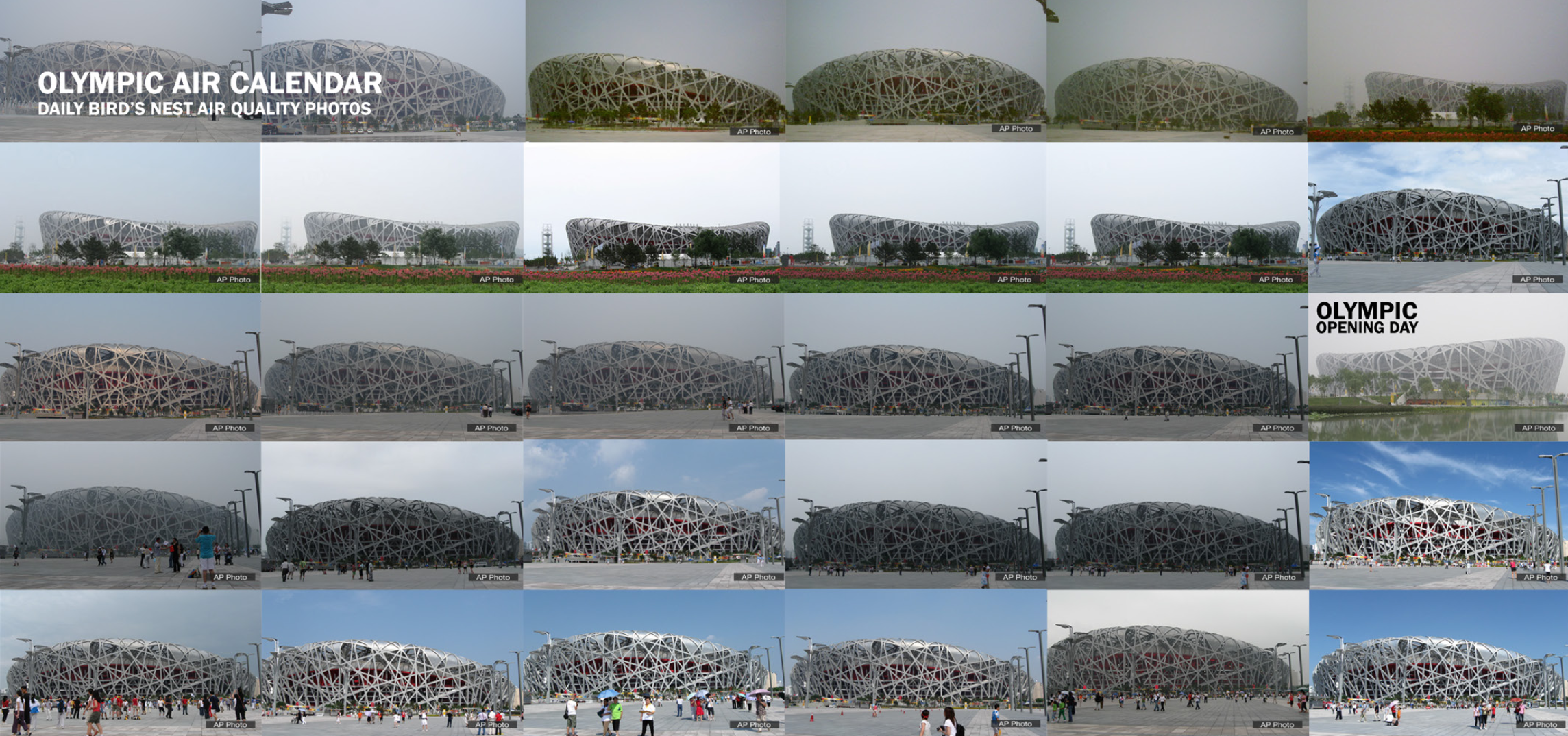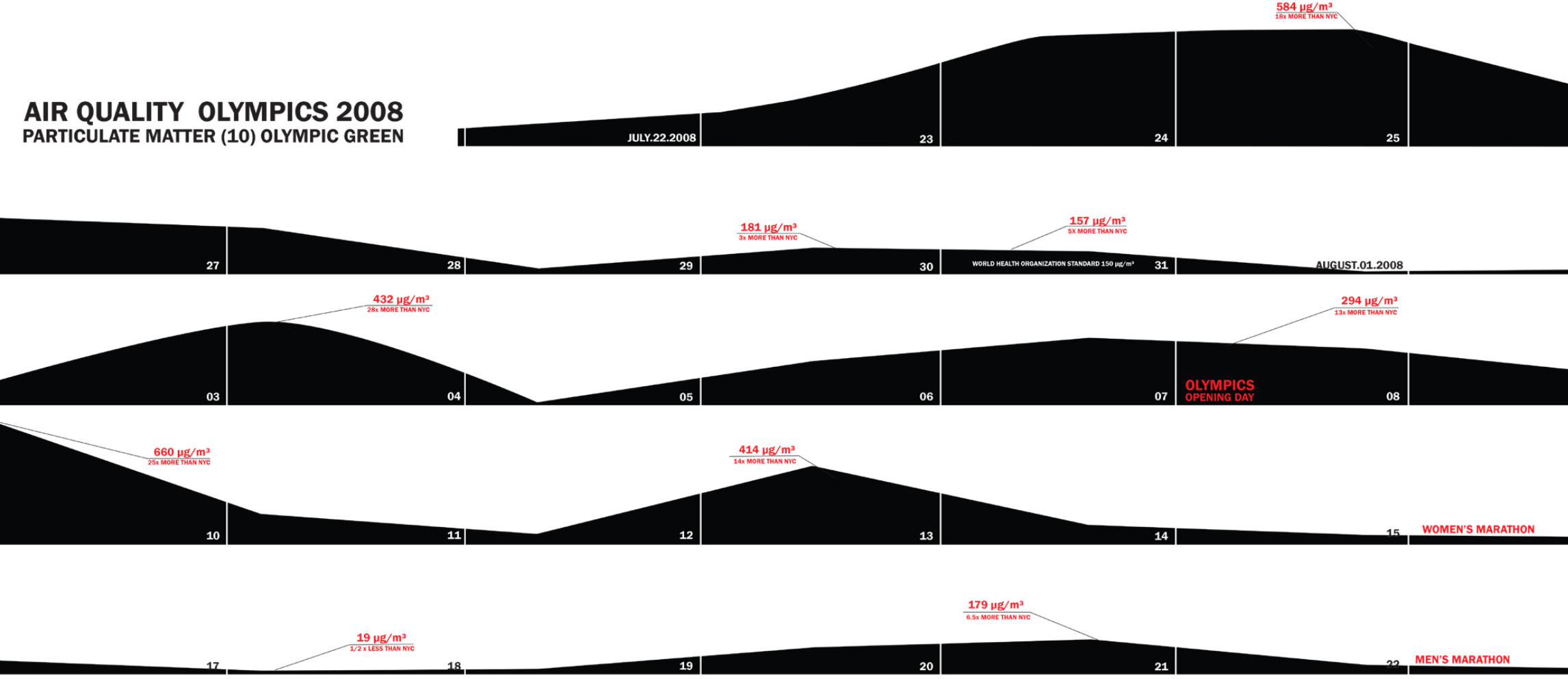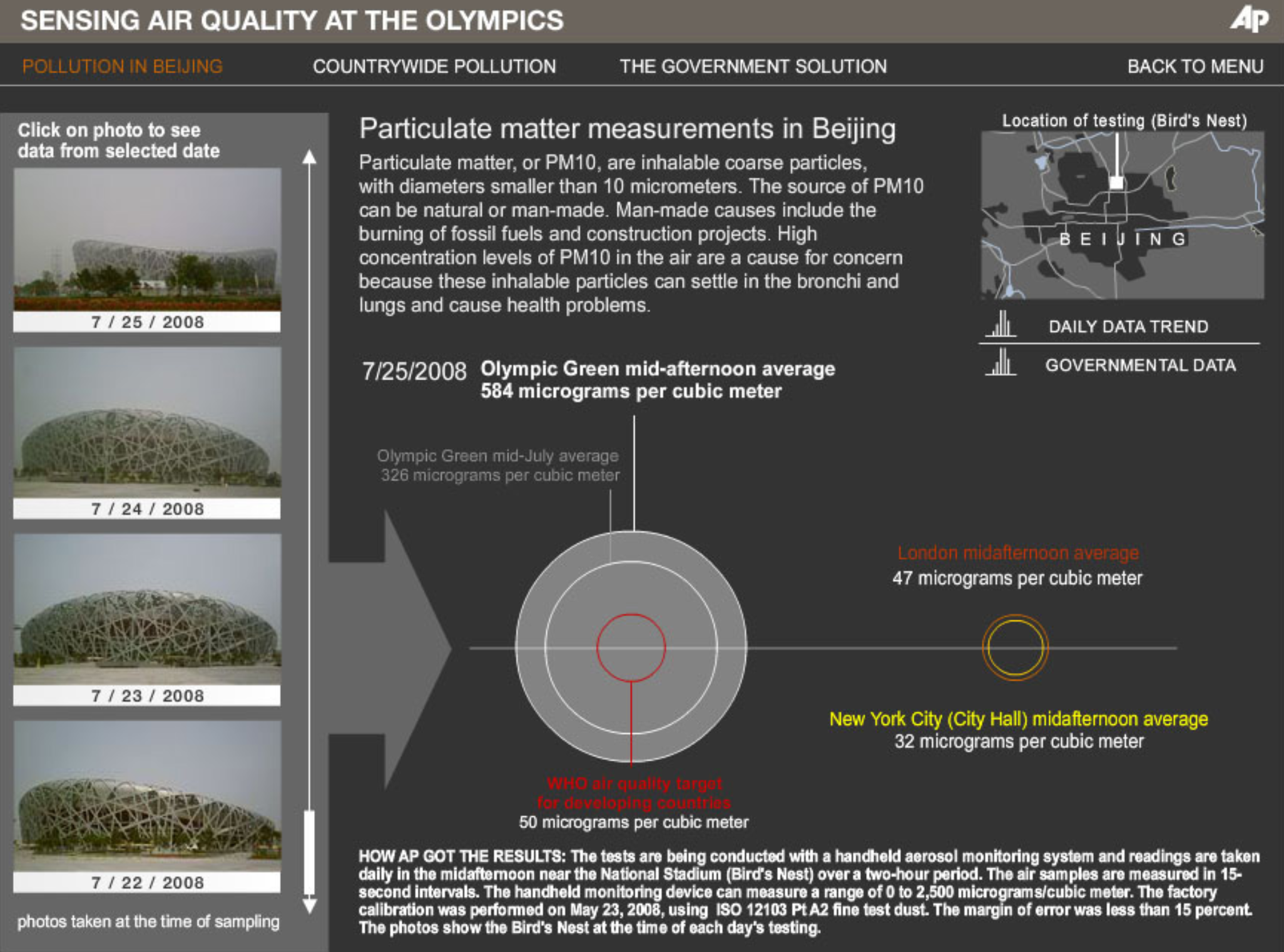Beijing Air Tracks
2008
Project Lead
Sarah Williams
Associated Press
Siemond Chan
Brian Horton
Research Assistants
Minna Niova
Robert Viola
Cressica Brazier
Support from
Associated Press
Project Lead
Sarah Williams
Associated Press
Siemond Chan
Brian Horton
Research Assistants
Minna Niova
Robert Viola
Cressica Brazier
Support from
Associated Press
Overview
The causes and effects of air pollution comprise a complicated chemical recipe that is all too easily reduced to superficial observation (the color of the sky) or an abstract statistical reading from static instruments. In reality, the total experience of a city’s air quality is a combination of highly localized as well as more regional effects that shift in intensity as one moves through an urban landscape.
In the months leading up to the 2008 Summer Olympics, Beijing’s poor air quality was a major source of concern as the host city struggled to fulfill its commitment to provide the best possible environment for athletes and visitors. With air that is typically two to three times dirtier than that of most Western cities, Beijing was under tremendous pressure to clear up its smoggy skies before coming under global scrutiny. Despite claims made by Chinese authorities that fog (not smog) was responsible for the low levels of visibility around the city, the government acknowledged the problem by putting into place a series of initiatives to dramatically curb pollution and visibly improve Beijing’s air quality. These included the removal of half the city’s 3.3 million cars from the road on alternate days; a temporary ban on 300,000 heavily polluting trucks; the phasing out of older buses and taxis in favor of newer models that use compressed natural gas; higher emissions standards for new cars; the temporary shuttering of dozens of steel, chemical, and cement factories and power plants; doubling the number of subway lines; the pause in all construction activities throughout the city more than two weeks ahead of the games; and the addition of urban parks, or “greenbelts” throughout the city.
Beijing Air Tracks combined air sensing with spatial dynamics to accurately assess the air quality of the Olympic host city. In collaboration with the Associated Press, Sarah Williams, at the time with the Spatial Innovation Design Lab, equipped journalists with handheld aerosol monitoring devices and GPS units, which tracked both the air quality (particulate matter and CO2) and the journalists’ geographic location as they moved throughout the city for their daily reporting. With unrivaled access to the Olympic venues, journalists gathered a month’s worth of data, which was then assessed as a time series to compare to average measurements in New York City and London. The results reflect a city reacting to positive localized change while struggling with larger regional pollution, and show the woeful irrelevance of administrative boundaries to environmental problems.
Measuring Air Quality
Air Quality data in the form of photographs and raw data obtained from sensors was turned into a visualizations which exposed the conditions in Beijing to larger audiences. The work was exhibited at Global Design Elsewhere Envisioned, New York University Gallatin School for Individualized Study, in 2011.


 Reducing Pollutants in Beijing. The New York Times, August 2008.
Reducing Pollutants in Beijing. The New York Times, August 2008.  Particulate matter levels we often higher than the World Health Standard for developing countries. One day it was 25 times higher than what you would see in New York City.
Particulate matter levels we often higher than the World Health Standard for developing countries. One day it was 25 times higher than what you would see in New York City. The Team developed an interactive piece that was distributed to AP subscribers, which allowed users to explore the data along with images which also clearly showed the pollution levels.
The Team developed an interactive piece that was distributed to AP subscribers, which allowed users to explore the data along with images which also clearly showed the pollution levels. Reducing Pollutants in Beijing. The New York Times, August, 2008.
Reducing Pollutants in Beijing. The New York Times, August, 2008.
Publications
Williams, Sarah, “Beijing
Air Tracks: Tracking Data for Good,” in Accountability Technologies Tools for Asking Hard Questions, Edited by Dietmar Offenhuber, Katja Schechtner, AMBRA, Vienna, Austria, 2013.
Williams, Sarah, and Archie Tse, “Pollution along the Olympic Marathon Route – Beijing 2008,” New York Times, August 18, 2008.
Williams, Sarah, Siemond Chan, and Brian Horton, “Measuring Pollution
– Beijing Olympics,” Associated Press, August, 2008.
Press
“Sensoring the News: Sensor Journalism Will Augment our Ability to Understand the World
and Hold Governments Accountable,” O’Reily Radar: News and Commentary, 2013.
“Reducing Pollutants in Beijing.” New York Times, 2008
Exhibitions
Air Tracks, Beijing, Open Source Data, Nairobi Global Design Elsewhere Envisioned, New York University Gallatin School for Individualized Study, New York, NY, 2011
Williams, Sarah, “Beijing
Air Tracks: Tracking Data for Good,” in Accountability Technologies Tools for Asking Hard Questions, Edited by Dietmar Offenhuber, Katja Schechtner, AMBRA, Vienna, Austria, 2013.
Williams, Sarah, and Archie Tse, “Pollution along the Olympic Marathon Route – Beijing 2008,” New York Times, August 18, 2008.
Williams, Sarah, Siemond Chan, and Brian Horton, “Measuring Pollution
– Beijing Olympics,” Associated Press, August, 2008.
Press
“Sensoring the News: Sensor Journalism Will Augment our Ability to Understand the World
and Hold Governments Accountable,” O’Reily Radar: News and Commentary, 2013.
“Reducing Pollutants in Beijing.” New York Times, 2008
Exhibitions
Air Tracks, Beijing, Open Source Data, Nairobi Global Design Elsewhere Envisioned, New York University Gallatin School for Individualized Study, New York, NY, 2011